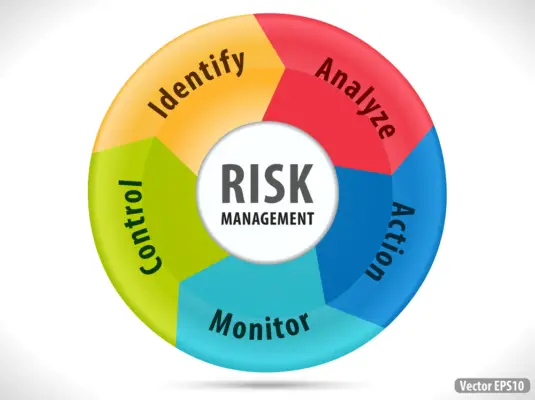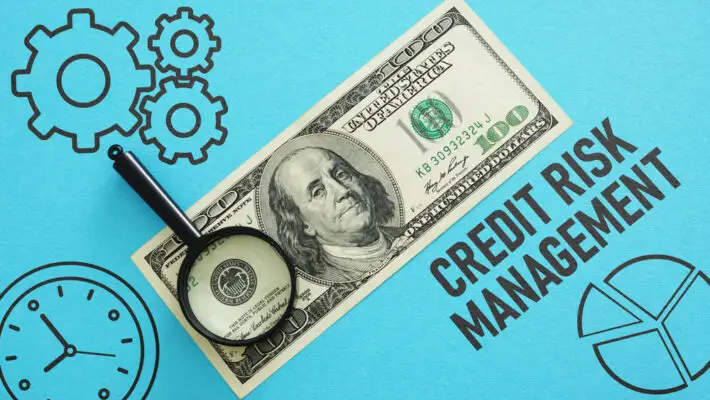Counterparty risk, also known as default risk or credit risk, is the risk that a party in a financial contract will not live up to their contractual obligations. Essentially, it’s the risk that the other party will default on a financial agreement.
This risk is particularly relevant in derivative transactions such as swaps, forwards, options, repurchase agreements, and securities lending. For example, if two parties enter into a swap agreement, there is a risk that one party may not fulfill its obligation, which could result in a financial loss for the other party.
Counterparty risk becomes especially significant in over-the-counter (OTC) markets where transactions are not standardized and take place directly between two parties without an intermediary, unlike exchange-traded derivatives, which have a clearinghouse as an intermediary that reduces this risk.
Factors that can affect counterparty risk include:
- Creditworthiness: The counterparty’s credit rating or financial health can impact the risk level.
- Market Volatility: High market volatility may increase the chances of a counterparty defaulting.
- The complexity of the Agreement: More complex agreements may carry higher counterparty risk, as there may be more ways for one party to default.
- Economic Factors: Broader economic conditions can affect counterparty risk. For example, during a recession, the risk of default may increase.
Financial institutions often manage counterparty risk through a combination of a careful selection of counterparties, collateral agreements, netting agreements (where multiple obligations to the same party are combined into a single amount), and hedging strategies.
Counterparty risk is a significant concern in both financial and non-financial sectors. It refers to the possibility that one party in a transaction may default on its contractual obligations, resulting in financial losses for the other party. This risk can arise from various sources, such as credit, market, operational, legal, and regulatory risks.
The impact of counterparty risk can be severe, leading to significant financial losses for parties involved in transactions. The global financial crisis of 2008 highlighted the importance of effectively managing counterparty risk. Institutions failed due to an inability to adequately manage their exposure to counterparty risks.
As such, organizations must identify and measure potential counterparty risks accurately, develop effective strategies for managing them, and implement appropriate tools for monitoring them continuously.

Types of Counterparty Risk
The classification of counterparty risk is based on the type of exposure and can be broadly categorized into five distinct types.
Pre-settlement Risk: This is the risk that a counterparty will default on a future obligation before the settlement date. It is particularly relevant in derivatives trading, where contracts often settle at a future date.
Settlement Risk: Also known as delivery risk, this is the risk that a counterparty will not deliver on their side of the deal at the time of settlement. For instance, in a securities transaction, one party might deliver the cash while the other fails to deliver the security.
Replacement Cost Risk: If a counterparty defaults, the non-defaulting party may need to replace the contract with a new one. If market conditions have changed, this could be done at a less favorable price, leading to potential losses.
Credit Risk: This is the risk that a counterparty will default due to deterioration of its creditworthiness or financial health. This risk can be influenced by various factors, from the counterparty’s financial situation to broader economic conditions.
Legal Risk: This is the risk that a counterparty may default due to legal reasons, such as being unable to fulfill a contract due to legal restrictions or regulatory changes.
Sovereign Risk: In transactions involving governments or government entities, there’s the risk that a sovereign state defaults on its obligations due to economic or political instability or policy changes.
Wrong-Way Risk: This occurs when exposure to counterparty risk is adversely correlated with the credit quality of that counterparty. For example, if a counterparty’s ability to fulfill its obligations under a derivatives contract decreases when the value of those obligations increases.
The first type of counterparty risk is credit risk, which refers to the possibility that a party may default on its obligations, leading to financial losses for the other party. Credit risk can arise in any contract where one party owes money or services to another.
The second type of counterparty risk is market risk, which arises from changes in market conditions that affect the value of a financial instrument. For example, if a company has entered into an interest rate swap with another party and interest rates rise unexpectedly, the value of the swap will decrease, exposing the company to potential losses.
Other types of counterparty risks include funding liquidity risk (the possibility that a party may not be able to meet its financial obligations due to liquidity constraints), operational risk (the possibility of loss arising from inadequate or failed internal processes or systems), and legal and regulatory risks (the possibility of loss arising from legal disputes or regulatory actions).
Understanding different types of counterparty risks is important for assessing potential losses and implementing appropriate measures to mitigate them.
Firms can manage their exposure by monitoring counterparties’ creditworthiness, conducting stress tests on portfolios, and diversifying exposures across multiple counterparties and asset classes.
Impact of Counterparty Risk
Understanding the potential negative consequences of engaging in financial transactions with other parties is crucial for assessing and managing overall financial risk.
Counterparty risk can significantly impact the outcome of these transactions, as it refers to the possibility that one party involved in a transaction will default or fail to meet its obligations.
The impact of counterparty risk can be both financial and reputational. The financial implications of counterparty risk are significant. If a counterparty fails to fulfill its obligations, it could result in financial losses for the other party involved.
In addition, depending on the nature of the transaction and the size of the loss incurred, it could have wider implications for an organization’s overall financial health. For example, if a bank has lent money to a counterparty that subsequently defaults, this could impact its profitability and liquidity.
Mitigation techniques are essential for managing counterparty risk effectively. Organizations must minimize their exposure to potential losses by identifying and monitoring counterparties’ creditworthiness.
This process includes analyzing their balance sheet strength, cash flow projections, historical performance data, and ratings from third-party agencies like Moody’s or Standard & Poor’s.
Additionally, organizations should consider implementing collateral agreements or insurance policies that protect defaulting counterparties. In summary, counterparty risk has significant implications for organizations engaged in financial transactions with other parties.
Mitigation techniques such as credit analysis and insurance policies are critical tools for minimizing this type of risk’s impact on an organization’s bottom line. It is essential to remain vigilant when assessing counterparties’ creditworthiness while engaging in financial activities involving third parties to avoid unnecessary losses due to defaulting counterparties.
Strategies for Managing Counterparty Risk
Organizations must implement appropriate strategies that prioritize creditworthiness evaluation and protection against default.
One such strategy is mitigating exposure by diversifying counterparties. By spreading out transactions among multiple entities with varying levels of risk, an organization can minimize the impact of a single counterparty defaulting.
Additionally, some organizations may use collateral agreements or credit insurance to protect themselves from potential losses further. Risk assessment is also a crucial aspect of managing counterparty risk.
Organizations must thoroughly evaluate their counterparties’ financial stability and creditworthiness before entering into any significant transactions.
In addition to these measures, organizations must establish clear contractual terms and conditions that outline each party’s responsibilities and obligations in the transaction.
This includes establishing dispute resolution mechanisms and defining what constitutes a default event.

Tools for Measuring Counterparty Risk
One important tool for measuring counterparty risk is using risk indicators, which can be used to assess the likelihood that a counterparty will default on its obligations. These indicators typically include credit spreads, bond spreads, and credit default swap prices.
In addition to using risk indicators, organizations can rely on credit ratings provided by independent rating agencies such as Moody’s or Standard & Poor’s. Credit ratings are assigned based on assessing a company’s financial health and ability to meet its obligations. A higher credit rating indicates a lower level of default risk.
However, it is essential to note that while these tools can be useful in assessing counterparty risk, they should not be relied upon solely.
Organizations should also consider other factors, such as the legal framework governing transactions with a particular counterparty and any relevant geopolitical risks that could impact their ability to fulfill their obligations.
Case Studies of Counterparty Risk
One such example is the bankruptcy of Lehman Brothers in 2008, which was caused by overexposure to subprime mortgages and resulted in significant losses for its counterparties. The failure highlighted the interconnectedness of financial institutions and the need for proper risk management.
Another case study is the collapse of Barings Bank in 1995 due to unauthorized trading by one employee, Nick Leeson. The bank failed to conduct adequate risk assessments and controls, allowing Leeson to accumulate large losses without detection.
The incident demonstrated how individual actions can have far-reaching consequences on an organization’s solvency, reputation, and relationships with counterparties.
These case studies demonstrate several lessons learned regarding counterparty risk management: first, it is crucial to assess risks comprehensively across various dimensions (credit, market, operational) rather than relying on simplistic or incomplete measures.
Secondly, it is important to monitor counterparties regularly and maintain open lines of communication; finally, organizations must prepare contingency plans for worst-case scenarios and test them regularly to ensure they are effective.
Frequently Asked Questions
What are some common misconceptions about counterparty risk?
These misconceptions include believing that counterparty risk is only relevant to large financial institutions or can be eliminated through diversification or collateralization.
However, these assumptions are inaccurate, as any entity engaging in financial transactions is exposed to counterparty risk.
Furthermore, while diversification and collateralization may reduce the likelihood of a default, they do not eliminate counterparty risk. Individuals and organizations must understand the real risks associated with counterparty risk and take appropriate measures to mitigate them.
How does counterparty risk differ in different industries or sectors?
The inter-industry comparison reveals that counterparty risk varies significantly across different sectors and industries. Factors such as the nature of the business, financial stability, regulatory environment, and market conditions contribute to this variation.
For instance, counterparty risk is high in the banking industry due to the interconnectedness of banks and their reliance on each other for liquidity and capital.
In contrast, the technology sector may have lower counterparty risk due to its less complex networks of counterparties.
Additionally, geopolitical events can impact counterparty risk; for example, political instability in a particular region could increase the likelihood of default by counterparties operating in that area.
An analytical approach based on data-driven insights is key to understanding these variations and developing effective strategies for managing counterparty risk across different industries or sectors.
What are the potential long-term effects of not effectively managing counterparty risk?
Failure to effectively manage counterparty risk can have significant long-term ramifications for financial stability and reputation damage.
Financial instability can arise due to the losses incurred from the inability of counterparties to meet their contractual obligations. This risk is particularly evident in industries or sectors with complex financial instruments, such as derivatives markets.
Additionally, reputational damage can occur when a company’s name is associated with the failure of its counterparties, leading to a loss of investor confidence and decreased market value.
How do regulatory changes or economic trends impact counterparty risk?
Regulatory compliance and market volatility are two factors that can significantly impact counterparty risk.
Regulatory changes may require companies to adjust their risk management strategies, leading to increased scrutiny of counterparties and potential changes in the terms of contracts.
In addition, market volatility can increase the likelihood of counterparty default, especially if a company’s counterparties are heavily exposed to a particular sector or asset class.
To effectively manage counterparty risk in these situations, companies must stay informed about regulatory developments and economic trends, assess their exposure to specific risks, and develop contingency plans for dealing with potential defaults.
What emerging technologies or innovations may impact how we assess and manage counterparty risk in the future?
Blockchain solutions and AI algorithms are emerging technologies that have the potential to revolutionize the way we assess and manage counterparty risk in the future. These innovations offer transparency, security, and efficiency that traditional methods simply cannot match.
For instance, blockchain technology enables parties to create tamper-proof records of transactions, which all relevant parties can access in real-time. This transparency reduces the likelihood of disputes or errors, reducing counterparty risk.
Similarly, AI algorithms can be used to analyze vast amounts of data related to counterparties, allowing for more accurate assessments of their creditworthiness and financial stability.
As these technologies continue to develop and mature, they will likely play an increasingly important role in mitigating counterparty risk across various industries.

Conclusion
Counterparty risk is a crucial aspect of financial transactions that must be carefully managed to avoid significant losses. The types of counterparty risks include credit, settlement, and operational risks.
These risks can have a detrimental impact on an organization’s financial stability and reputation. Therefore, strategies for managing counterparty risk are essential to ensure business continuity and growth.
Organizations can utilize various tools to measure counterparty risks, such as credit ratings and quantitative models. Still, these tools may not always provide accurate predictions. Thus, it is imperative to supplement them with qualitative assessments based on market insights and industry expertise.
Moreover, case studies illustrate the importance of managing counterparty risk in mitigating potential losses from unexpected events.
Managing counterparty risk requires a comprehensive approach incorporating quantitative and qualitative analyses to minimize loss exposure while ensuring business continuity.
Counterparty risk can be likened to a game of chess; each move must be calculated strategically to protect one’s position while exploiting growth opportunities. Therefore, organizations must remain vigilant in effectively managing this critical aspect of financial transactions.

Chris Ekai is a Risk Management expert with over 10 years of experience in the field. He has a Master’s(MSc) degree in Risk Management from University of Portsmouth and is a CPA and Finance professional. He currently works as a Content Manager at Risk Publishing, writing about Enterprise Risk Management, Business Continuity Management and Project Management.

